June 1, 2013 Water Supply Forecast Discussion
The Colorado Basin River Forecast Center (CBRFC) geographic forecast area includes the Upper
Colorado River Basin, Lower Colorado River Basin, and Eastern Great Basin.
Seasonal Water Supply Forecasts:
Quick Summary:
Forecast volumes have increased since last month in the Colorado River headwaters and upper Gunnison Basin due
to above average precipitation in May. Elsewhere forecasts generally decreased. Some adjustments can be attributed
to streamflow volumes observed so far this spring.
Near average streamflow volumes are expected in the Colorado River headwaters. Below to much below April through July
runoff is forecast throughout the San Juan, Gunnison, Yampa, Green and Great Basins.
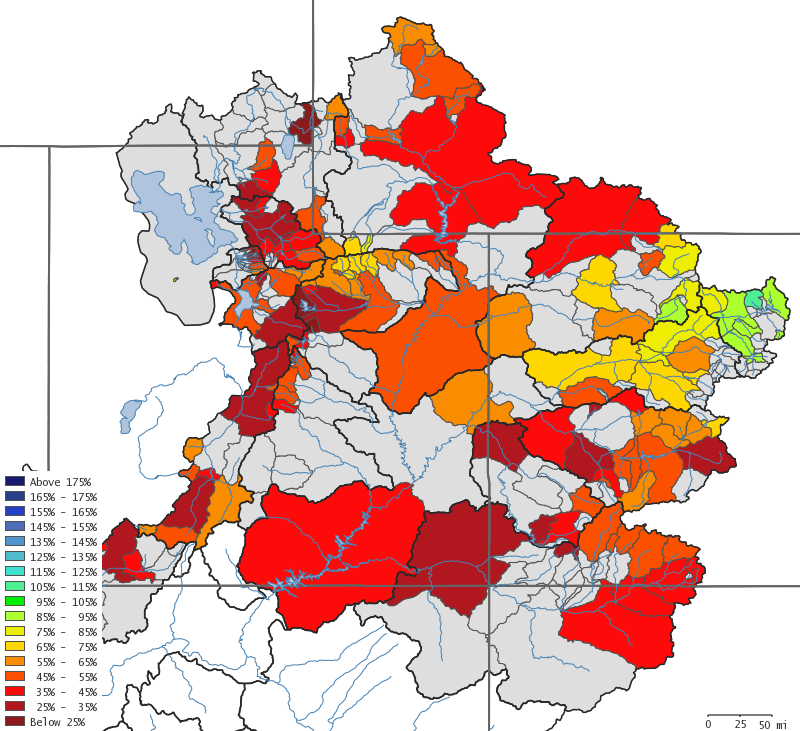
Image: River basin map for the April-July runoff forecast period. Forecasts are expressed as a percent of average.
Click here for specific site water supply forecasts
Water Supply Discussion
Weather Synopsis:
A strong ridge of high pressure the second week of May resulted in above average temperatures and an increase
in snow melt and streamflow. During the latter part of May low pressure systems developed over the eastern Pacific
and northwest U.S. This resulted in cooler and unstable air occasionally making its way into the northern half of the
CBRFC area. Due to the convective nature of the precipitation some areas experienced above average precipitation during
May, while nearby areas were much below average.
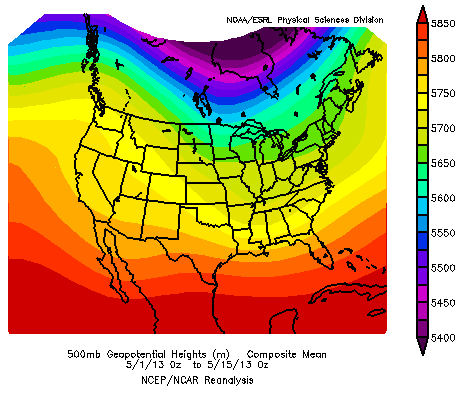
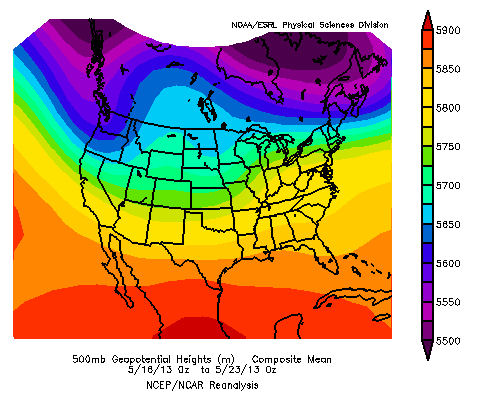
Image: Mean upper air pattern over the continental U.S. for May 2013. A strong ridge of high pressure during the second
week of May resulted in much above average temperatures (left). Below average temperatures with occasional precipitation was
observed during the latter part of May (right) over the northern CBRFC area
Precipitation and Temperature:
Most areas received below average precipitation during the month of May. Exceptions to this included the Upper Gunnison
Basin and Colorado River headwaters where above average precipitation was more widespread. Localized areas of above average
precipitation also occurred due to the convective nature of the precipitation that resulted in heavier rain showers.
A wet April and May brought seasonal (October-May) precipitation values to near or above average in the Colorado River headwaters.
Near average seasonal precipitation was also noted in some lower elevations of the Yampa Basin and northern Great Basin, however
this was not widespread and did not occur in the areas that contribute significantly to seasonal streamflow runoff. The majority of
the CBRFC area ended up with below to much below average seasonal precipitation. In the San Juan Basin seasonal precipitation was
generally below 70 percent of average.
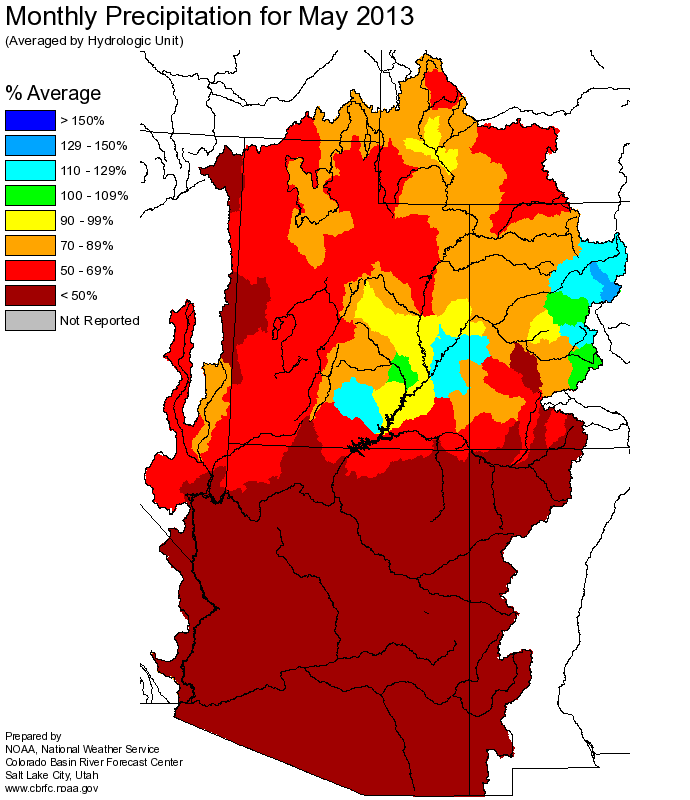
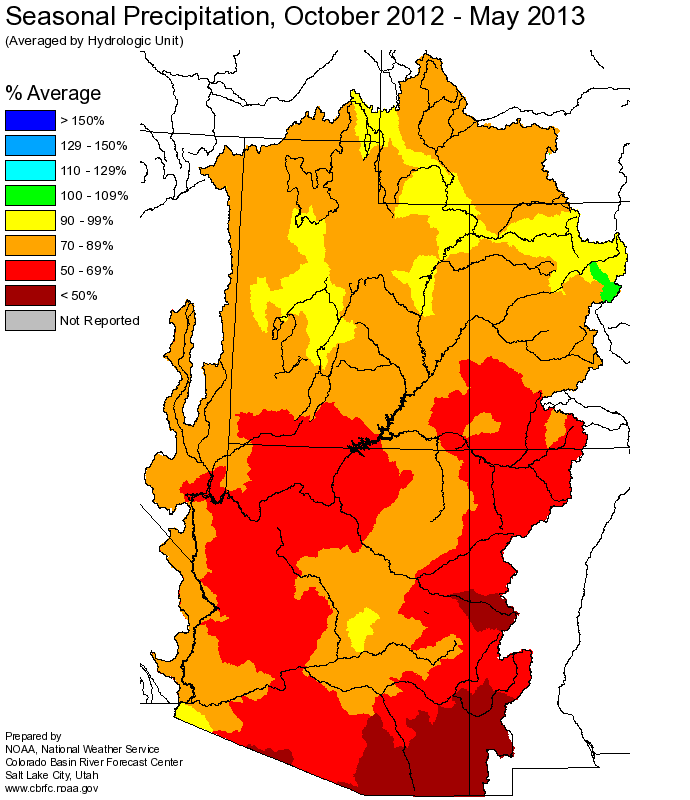
Image: May 2013 monthly precipitation as percent of average and October through May 2013 seasonal precipitation as percent of average.
Typical of May there were large temperature swings during the month with periods of much above average temperatures followed
by a period of below average temperatures. The monthly average temperatures ended up near or slightly below average for most
areas. The week to week variations in temperatures are not adequately represented in the monthly image below. During the second
week of May temperatures, particularly in the Great Basin and lower Green Basin, were as much as 10-20 degrees above average for
several days.
.
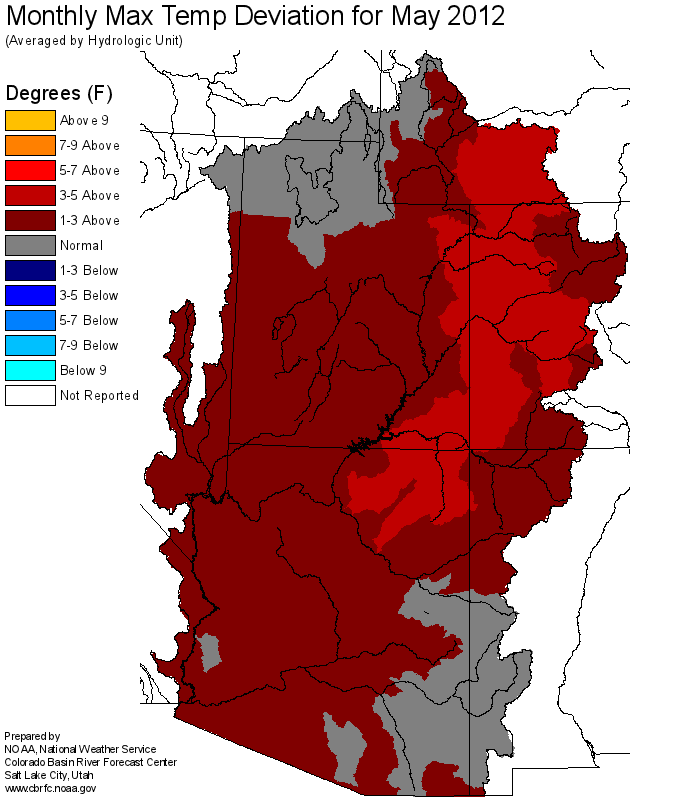
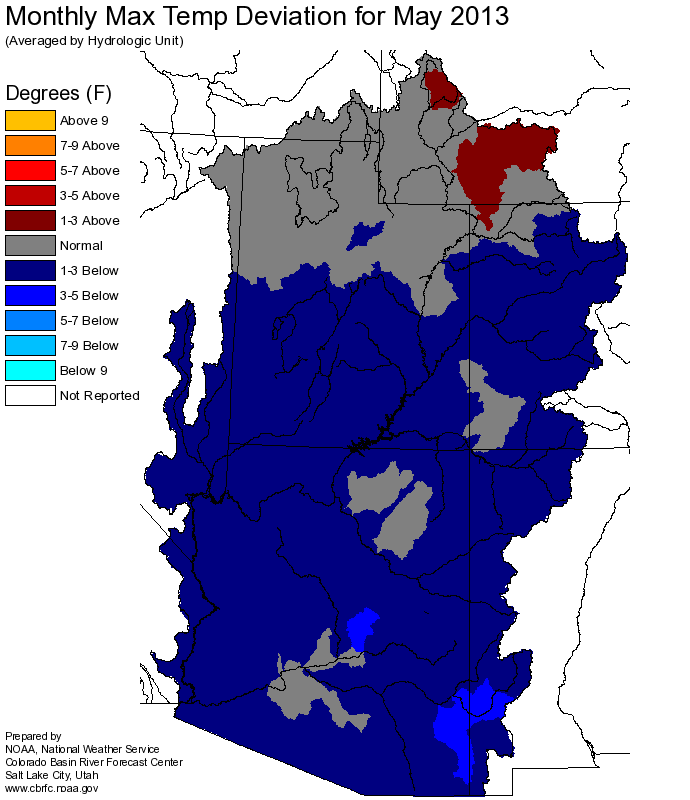
Image: May 2012 and May 2013 maximum temperature departure from average.
Snowpack:
The snowpack has been depleted at most SNOTEL measuring sites with the exception of highest elevation sites and at several
locations in the Colorado River headwaters where a wet April and May dramatically improved the snowpack conditions. Elsewhere
the snow melted out early due to several factors, most notably the above average temperatures experienced the first part of May
combined with a below average snowpack.
The map below is a display of Snow Water Equivalent (SWE) at SNOTEL sites as a percent of the 1981-2010 average.

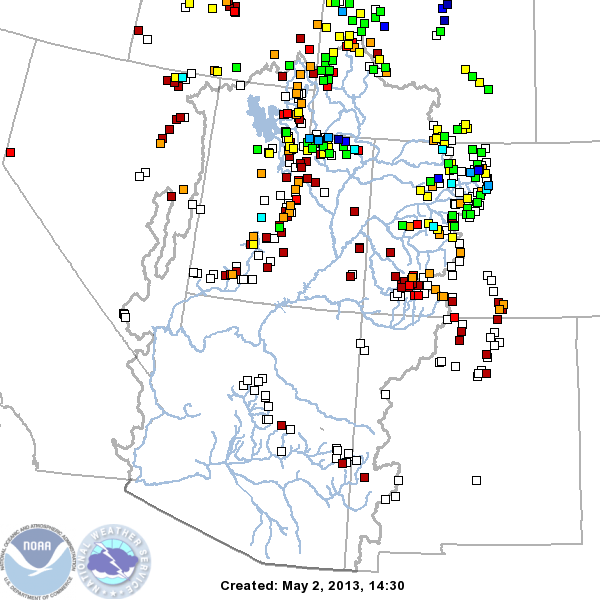
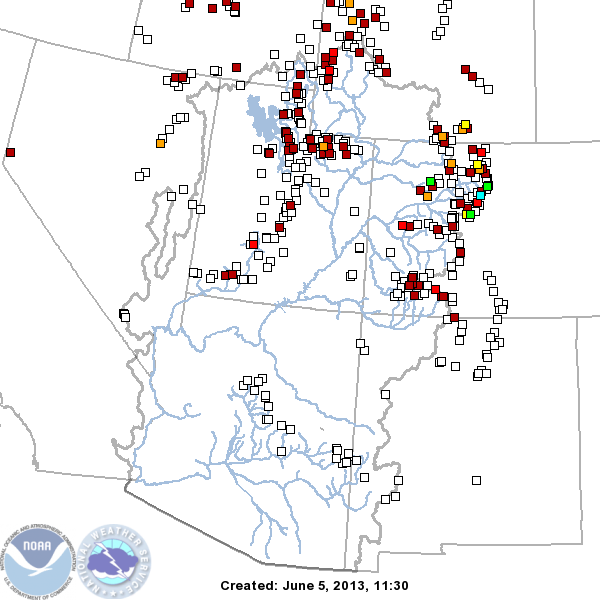
Image: CBRFC Snow Conditions Map as a percent of average for May 2013 and June 2013
Soil Moisture:
Soil moisture conditions in the higher elevation headwater areas are important entering the winter, prior to
snowfall, as it influences the efficiency of the snow melt runoff. Last fall, modeled soil moisture conditions
were below average throughout the upper and lower Colorado Basins. In northern Utah, modeled soil moisture was
closer to average in parts of the Bear, Weber, Provo, Six Creeks, and Duchesne Basins due to a late October storm
and high elevation rainfall. This is also true for some of the upper Green River Basin headwaters in Wyoming.
See the map below for a more detailed view.
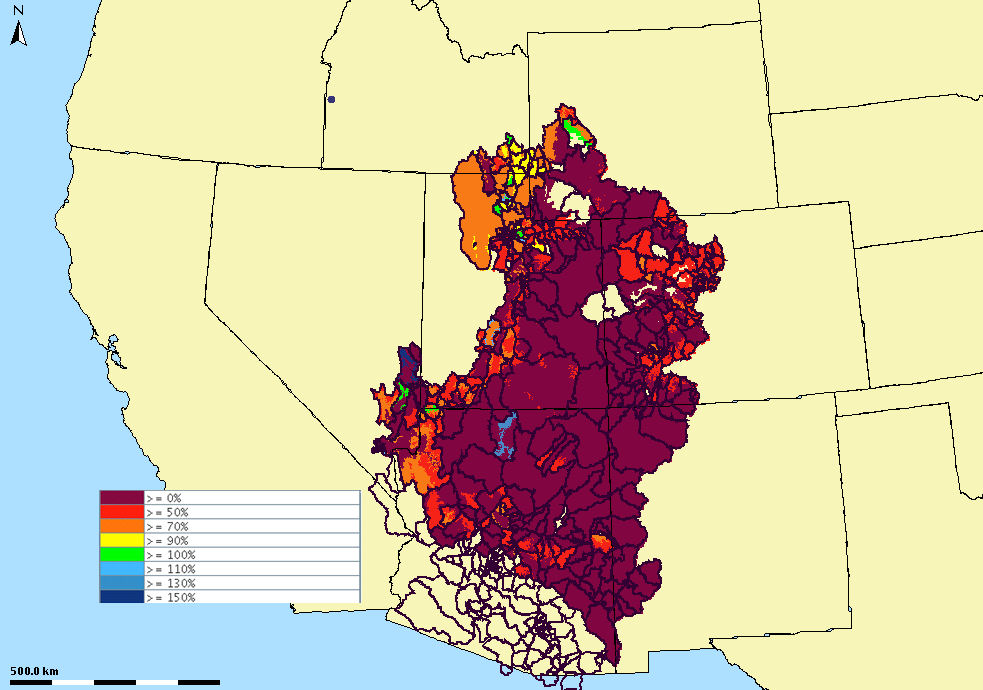
Image: Modeled soil moisture states (as a percent of average) on Dec 31 2012
Streamflow:
Streamflows fluctuated significantly during May due to the episodic warm and cool periods and the resulting rate of
snow melt. Streamflow volumes during May were below average reflecting both the below average snowpack and low
antecedent soil moisture conditions prior to the season.
Climate Outlook:
The El Nino Southern Oscillation (ENSO) condition is considered neutral and this is expected to continue through
the northern hemisphere through 2013. The Climate Prediction Center indicates equal chances for above or below average
precipitation throughout the CBRFC forecast area.
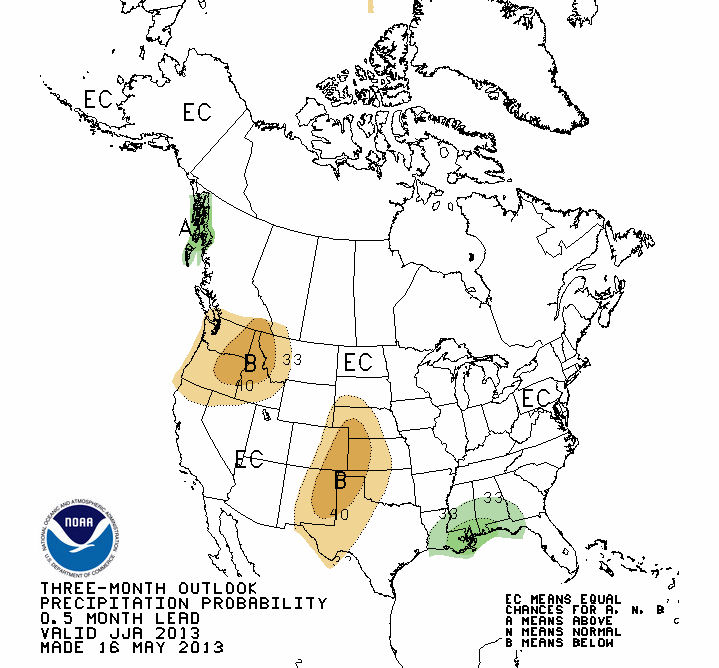
Image: Climate Prediction Center 3 month precipitation outlook
Conclusion:
Above average precipitation continued for a second consecutive month in the Colorado River headwaters resulting
in an increase in the April-July forecast streamflow volumes there. Minor increases in forecast volumes also
occurred in the Gunnison Basin above Blue Mesa Reservoir. Elsewhere forecasts were generally reduced slightly
due to below average precipitation in May. The April-July forecast volumes issued in early June contain two
months of observed runoff (April-May). Some of the adjustments to the April-July volumes can be attributed to the
runoff observed so far this spring.
End Of Month Reservoir Content Tables
Green River Basin
Upper Colorado River Basin
San Juan River Basin
Great Salt Lake Basin
Sevier Basin
Virgin River Basin
Basin Conditons and Summary Graphics
Green River Basin
Upper Colorado River Basin
San Juan River Basin
Great Salt Lake Basin
Sevier River Basin
Virgin River Basin
Definitions
10% exceedance forecast: Given the current hydrometeorological conditions, i.e current snowpack, soil moisture and streamflow, the volume that has a 10% chance of being exceeded. Previously referred to as "Reasonable Maximum Forecast".
50% exceedance forecast: Given the current hydrometeorological conditions, i.e current snowpack, soil moisture and streamflow, the volume that has a 50% chance of being exceeded. Previously referred to as "Most Probable Forecast".
90% exceedance forecast: Given the current hydrometeorological conditions, i.e current snowpack, soil moisture and streamflow, the volume that has a 90% chance of being exceeded. Previously referred to as "Reasonable Minimum Forecast".
Acre-Foot (af):
The volume equal to one acre covered one foot deep (43,560 cubic feet). See kaf below.
Average:
The arithmetic mean. The sum of the values divided by the number of values. Values from 1981-2010 are used for this publication.
Categories:
Much Above Average=Greater than 130%, Above Average=111-130%, Near Average=90-110%, Below Average=70-89%, Much Below Average=Less than 70%.
CBRFC:
Colorado Basin River Forecast Center.
Forecast Period:
The period from April 1 through July 31, unless otherwise noted.
kaf:
Thousand Acre-Feet. See Acre-Foot above.
Inflow:
The volume of water that flows into a reservoir or lake.
Median:
The middle value of an ordered set of values. Half of the values are higher and half of the values are lower. When the set contains an even number of values the median is the average of the two middle numbers.
NOAA:
National Oceanic and Atomospheric Administration.
NWS:
National Weather Service.
Rounding Conventions:
| Range | | Round to |
| 0-1.99 | | 0.01 |
| 2.0-19.9 | | 0.1 |
| 20-199 | | 1.0 |
| 200-999 | | 5.0 |
| 1000+ | | 3 significant digits |
Streamflow:
The volume of water that flows past a specific stream site.
Water Year:
The 12-month period, October 1 through September 30. The water year is designated by the calendar year in which it ends. Thus, the year ending September 30, 2008, is called the "2008 water year."
Additional Information
Water supply forecasts take into consideration present hydrometeorological conditions and use
average basin temperatures and precipitation for the forecast period. As the forecast season progresses,
a greater portion of the future hydrologic and climatic uncertainty becomes known and
monthly forecasts become more accurate. For more information on the tools we use, consult
Water Supply Forecasting Tools.
Volume forecasts represent adjusted flows; that is, observed flows with upstream water use
taken into account. Adjusted flows will closely approximate natural or unimpaired flows.
However, not all upstream diversions or impoundments are measured or quantifiable. For specific
adjustments used with each forecast point, consult the
Guide to Water Supply Forecasting.
The Water Supply Outlook is issued monthly January through May by the Colorado Basin River
Forecast Center. It represents a coordinated effort between the
National Weather Service, Natural Resources Conservation Service, Bureau of Reclamation, U.S.
Geological Survey and local water district managers.
Note: Data used in this report are provisional and are subject to revision.
For more information, or to be included on the mailing list, please contact:
Colorado Basin River Forecast Center
2242 W North Temple
Salt Lake City, UT 84116
(801) 524-5130
www.cbrfc.noaa.gov











